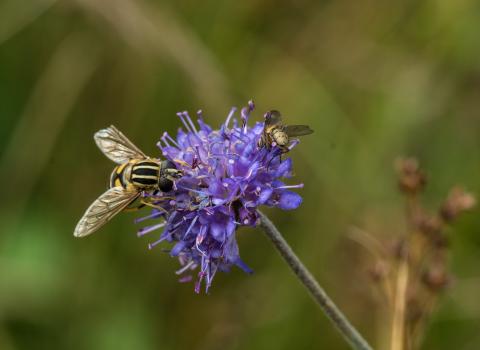Location
Know before you go
Dogs
When to visit
Opening times
Reserve open at all timesToilets open daily, 9 am - 4.30 pm.
Best time to visit
April to OctoberAbout the reserve
Highlights
- Visit in late summer to see swathes of beautiful purple heather in flower.
- Are you creepy crawly crazy? Come and see some of our nationally-rare insects.
What lies beneath?
Walk along any of the sandy paths on Highgate Common and you can not fail to notice countless small holes. These holes are made by ground nesting solitary bees & wasps. Highgate Common is one of the best places in the country to spot these fascinating insects, but please don't be scared, over time their stings have become so small that you would be very unlucky to be stung.
It has been estimated that 140 different types of solitary bee and wasp live on the Common. Some of the bees and wasps living on Highgate are extremely rare in the UK, and Highgate Common has been made a Site of Special Scientific Interest because of these rare creatures.
Rarer than rainforest!
Highgate Common is a small remnant of an ancient lowland heath which used to stretch for over 15 miles. Lowland heath is a fantastic habitat for wildlife, however since the 1800's the UK has lost 80% of its open heathland and it is now rarer than rainforest. However, the UK is still responsible for safeguarding almost a fifth of the world's remaining heathland. On Highgate Common, we are carefully restoring the heathland by encouraging heather to regenerate and controlling the spread of birch and bracken.
Creepy crawly crazy
It’s not just the solitary bees and wasps that love living on Highgate, the Common is also home to over 5,000 different types of insect including dazzling heathland dragonflies which dart around our pools, rare glow worms, countless beautiful butterflies such as the purple hairstreak and white admiral, and many fantastic beetles such as the rare black oil beetle, green tiger beetle and wonderful bloody-nosed Beetle.
Miniature Monsters Trail
Families can now discover the fascinating creepy crawlies that live right here on Highgate Common thanks to the new Miniature Monsters Trail! Follow the Oil Beetle or Mining Bee Trails made up of 10 interpretation boards and be introduced to some of the amazing characters that live on the reserve. From the black mining bee, to the bog bush cricket, there's literally thousands of insects to discover! Read to start exploring? Click here.
Don’t like creepy crawlies?
If insects just aren’t your thing, don’t worry! Highgate Common’s heathland is also home to grass snakes, common lizards and slow Worms! The heathland is also visited by some wonderful birds including cuckoo, yellow hammer, tree pipit and green woodpecker. It is well worth a visit in the springtime to experience the birdsong echoing over the Common.





